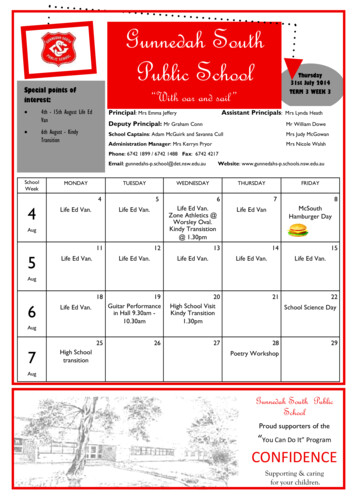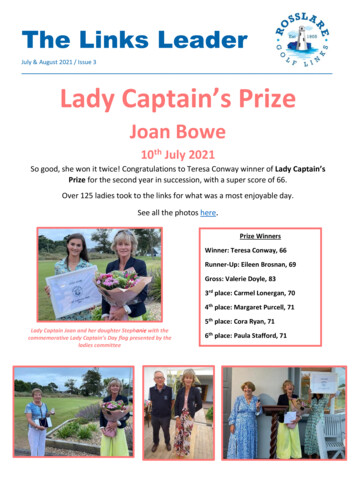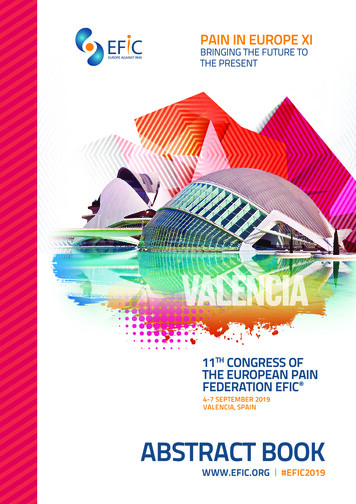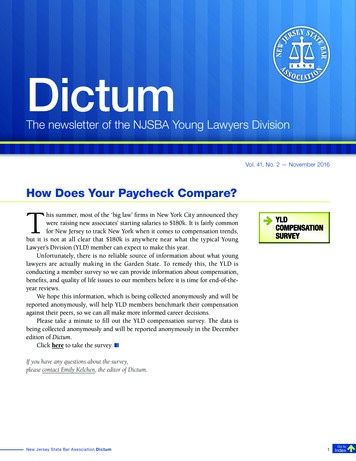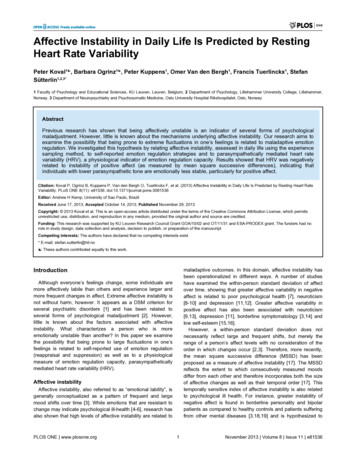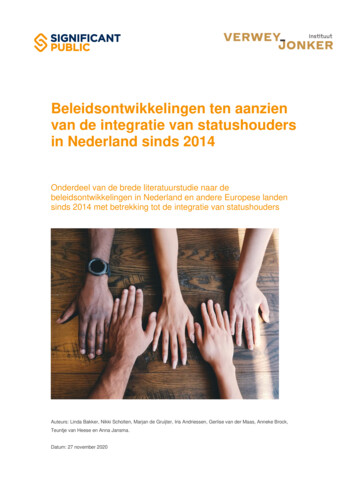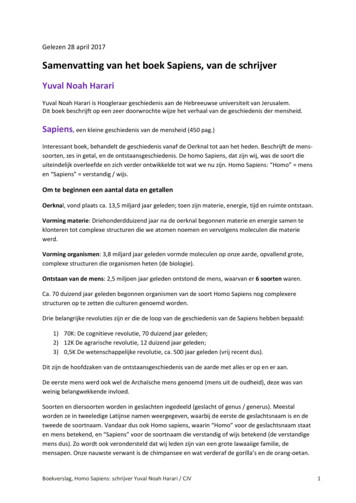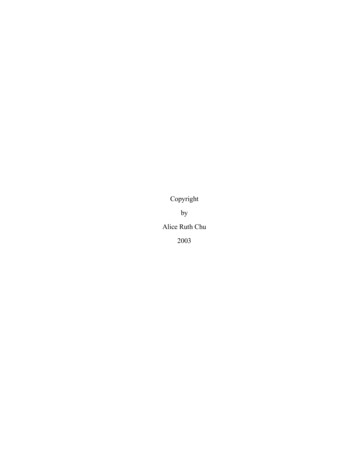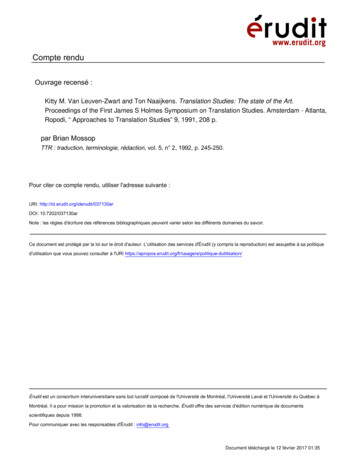
Transcription
Compte renduOuvrage recensé :Kitty M. Van Leuven-Zwart and Ton Naaijkens. Translation Studies: The state of the Art.Proceedings of the First James S Holmes Symposium on Translation Studies. Amsterdam - Atlanta,Ropodi, “ Approaches to Translation Studies” 9, 1991, 208 p.par Brian MossopTTR : traduction, terminologie, rédaction, vol. 5, n 2, 1992, p. 245-250.Pour citer ce compte rendu, utiliser l'adresse suivante :URI: http://id.erudit.org/iderudit/037130arDOI: 10.7202/037130arNote : les règles d'écriture des références bibliographiques peuvent varier selon les différents domaines du savoir.Ce document est protégé par la loi sur le droit d'auteur. L'utilisation des services d'Érudit (y compris la reproduction) est assujettie à sa politiqued'utilisation que vous pouvez consulter à l'URI tilisation/Érudit est un consortium interuniversitaire sans but lucratif composé de l'Université de Montréal, l'Université Laval et l'Université du Québec àMontréal. Il a pour mission la promotion et la valorisation de la recherche. Érudit offre des services d'édition numérique de documentsscientifiques depuis 1998.Pour communiquer avec les responsables d'Érudit : info@erudit.orgDocument téléchargé le 12 février 2017 01:35
La traduction, la terminologie et larédaction en chronique (8)Brian Mossop, Paul St-Pierre, Agnès WhitfieldKitty M. VAN LEUVEN-ZWART and Ton NAAUKENS. Translation Studies: The State of the Art.Proceedings of the First James S Holmes Symposium onTranslation Studies. Amsterdam - Atlanta, Rodopi,11Approaches to Translation Studies" 9,1991, 208 pp.This is a collection of papers delivered at a December 1990 symposiummarking the 25th anniversary of the Department of Translation Studies atthe University of Amsterdam. (The editors are to be congratulated ongetting the material into print just six months after the event, though oneunfortunate result is the lack of an index.) Each contribution takes as itspoint of departure the papers by the late James Holmes published under thetitle Translated! (Rodopi, 1988). The book will serve as an introduction toHolmes and an update on his program for Translation Studies (TS).An interesting paper by Hans HÖNIG uses recent empirical studiesof the mental process of translation to develop Holmes' notion (1988, p. 83)that translators create mental maps of the source text and the projectedtranslation. Raymond van den BROECK looks at Holmes' development ofJift' Levy's use of game theory to describe the activity of the translator.Peter VERSTEGEN, in an avowedly normative paper, says that some of theoptions Holmes sets out for translation (1988, p. 49) are not or should notbe used, but he seems to miss Holmes' theoiy-mindedness: Holmes wastrying to show all the possible ways of translating on a graph (the X-axisrepresenting exoticizing vs naturalizing translation, the Y-axis historicizing245
vs modernizing), with one graph for each of three aspects of a text —linguistic, literary and socio-cultural. Theory would then try to explain whysome options are used at particular times and places.José LAMBERT and Gideon TOURY both discuss the relationships among Holmes' three divisions of TS — theoretical, descriptive andapplied studies. Lambert points out that theory has tended to be a justification for applied TS (i.e. for this or that approach to translation pedagogy orcriticism) rather than an explanation of the findings of descriptive TS.Toury suggests that 'laws of translation* confirmed by observation can beapplied in translation pedagogy: students can be taught to consciouslycounter certain observable tendencies toward information loss. TheoHERMANS discusses the role of translation norms as a form of socialbehaviour, that is, as a part of descriptive rather than applied TS.The problem of defining TS takes up a large part of the book andwill be the focus of this review, with emphasis on theoretical TS. In MarySNELL-HORNBY's discussion of Holmes* trail-blazing 1972 paper "TheName and Nature of Translation Studies," she states that:The need to delimit the field is now less acute than it was twentyyears ago; the tendency is rather to look for points of contact. Ihthis environment translation, which by nature involves manydisciplines, can flourish, and so broad is our field that GideonToury's term inter-discipline seems to me the most apt one todescribe it. (p. 19)This somewhat complacent outlook is characteristic of themetatheoretical reflections in the book, my main criticism of whichconcerns not what it does but what it fails to do. Instead of debating thelimits of the field, it simply endorses a broad pluralism. (Perhaps there wasoral debate at the Symposium, but it is not reflected in this publication —a common failing of the "proceedings" genre.)If the study of translation was once defined too narrowly, as abranch of applied linguistics, it is now in danger of hyperexpansion, ofbecoming a mere meeting-place for anyone interested in translation for anyreason. Certainly one wants to draw concepts from many disciplines (eventheoretical physics: cf. Barbara Folkart, "Translation and the Arrow ofTime" in TTR, 11:1). But that leaves the question of what they are appliedto. Should TS not follow Saussure's approach to language, and distinguish246
translating as a focus of interest from translating as an illustration of someother problem or some more general type of activity?Much writing on translation is really addressed to broad questionsabout communication or knowledge or culture, given their necessarymediation by language. This is true of Quine on the "indeterminacy oftranslation" — discussed here in a paper by Anneke van LUXEMBURGALBERS about Holmes' reflections on the translatability of one line of aDutch poem — and it is true of Jacques Derrida's numerous reflections ontranslation. It is one thing to apply specific deconstructionist concepts, asHolmes suggested (1988, pp. 106-107); it is something else to turntranslation theory into a general meditation on différence, metaphor andphilosophy.Thus Matthijs BARKER & Ton NAADKENS suggest in theirpaper that Holmes' distinction between secondary and original writingcannot be sustained. Gesturing to the deconstructionists, they say that "theworld is always already translated, that is, transformed into language" (p.196), and they cite Proust in support: "Ie devoir et la tâche d'un écrivainsont ceux d'un traducteur." (In this passage of Le Temps retrouvé, the"translation" in question is that of personal memories into writing: thenarrator says of "the only true book" that "it is not the task of a great writerto invent it in the ordinary sense, for it already exists in each of us, but totranslate it.")What is annoying here is that the authors simply mention all thisin passing. Surely what amounts to a suggestion that translation theorybecome a general theory of writing requires detailed justification.The word "translation" certainly lends itself to extension: one canspeak of translating metaphor or jargon into abstract or plain language;translating the content of dreams into language, or a poem into music; ortranslating one's thoughts into language. In 1978, Igor Mel'öuk proclaimedin Meta (XXIII:4, p. 271) that linguistics is the study of translation, sincelanguage is a device for "translating" meaning into text. One wonderswhether such metaphorical extensions of the word really achieve anyinsight.Even a limitation to texts-based-on-other-texts leaves a very broadfield indeed for TS. What you are now reading could be described as my"translation" of the book under review (in its turn a "translation" of247
Holmes' papers). I am responding to the book by quoting, summarizing andcommenting on it to you, just as a translator reports to target-languagereaders what the source-text author wrote.Bakker & Naaijkens' starting point is Holmes' "fan" of metaliterary forms — ranging from a critical essay on a poem to a versetranslation of the poem to a poem inspired by the poem (1988, p. 24). Theysuggest (p. 196) mat Holmes viewed these forms as a cline, one blendinginto another, but a close reading of Holmes does not really support this: heuses inverted commas when describing a critical essay as "translating" apoem (1988, p. 24), and in his "Name and Nature" paper he explicitlyrestricts the field to interlingual translation (1988, p. 80).Even where a cline does exist between two phenomena X and Y,they are still distinguishable. Observations at the border between X and Y,or within Y, may be revealing about X but that does not mean a jointtheory of X and Y is desirable. In a given society, the word "translation"or its equivalent may be applied or extendable to other metatexts, but itdoes not follow that a general theory of re-writing is wanted. Sciences haveto constitute their object, not take it ready-made from passing linguisticusage. Was there any debate on such matters at the Symposium?Consider how some feminist theorists have been moving beyondtopics such as loss of references to women's experience when texts aretranslated, or the role translators might play in enriching the target languageto reflect women's presence. In The Body Bilingual: Translation as ReWriting in the Feminine (Toronto, Women's Press, 1991), Susanne deLotbinière-Harwood speaks of "two registers of translation: from SL to TLand from masculine to feminine." As a gay man, Holmes would doubtlesshave been interested in the general problem of making texts reflect theexperience of people other than heterosexual men. But would he havethought it a task for translation theory?Whatever parallels might exist between translation and other kindsof re-writing (e.g. the derived text necessarily differs from the source textin meaning), translation could well prove to be distinct psycholinguistically,and it is certainly a distinct socio-political activity, since translation is thelinguistic component of international relations. One might propose a theoryof those aspects of translations and other metatexts which they have incommon, though if the aim is to carve out a niche for TS, there will becompetition here from other disciplines: in Translation and Relevance248
(Blackwell, 1991), Ernst Gutt claims there is no need for a separatetranslation theory, since translation can already be accounted for as an"interpretive use" of language within Sperber & Wilson's Relevance Theoryof pragmatics, a subfield of linguistics.What theory needs is not hyperextension but — as GideonTOURY says (p. 186) — a gradual transition from what Holmes calledpartial theories of (interlingual) translation to a general theory. Such atheory might well situate translation with respect to other kinds of rewriting, but more importantly it would unify or at least articulate the greatrange of geolinguistic situations in which translation is and has been done,and the many media of translation: oral, written, human, machine, signing,dubbing. While progress has been made toward a unified picture of thetranslation of different text-types, Holmes' diagnosis of the state of affairsin 1972 still holds true:Most of the theories that have been produced to date are. bothtoo inclusive (covering also non-translatory acts.) and tooexclusive (shutting out some translatory acts.). (1988, p. 73)Snell-Homby notes (p. 21) that TS conferences typically drawscholars from just a few countries. Participants are familiar with only arestricted range of the world's translating situations, media and text-types.This Symposium, reflecting Holmes' interest in poetry though not hisdefinition of TS, seems to have been heavily focussed on European literarytexts — with the usual attendant prejudices. Did anyone challenge ArminPaul FRANK'S assertion (pp. 118-119) that literary texts have a specialontological status as "primary texts" because the meaning of other genres("instruction manuals, museum catalogues. court proceedings") can beclarified by reference to some pre-existing reality? One wonders whetherFrank has ever translated a court proceeding.Also, since ten of the sixteen papers are by Dutch and Belgianscholars (the only other countries represented being Germany, Austria,Slovakia and Israel), one is tempted to paraphrase the book's title: "the stateof TS as understood in the Low Countries." It might have been useful toinvite Antoine Berman, who was still alive at the time, to compare Holmes'views to his own eleven-point program of 1986 for la traductologie (cf "Latraduction et ses discours," reprinted in Meta XXXIV:4, 1989).249
The barriers to advances in theoretical TS will not be removed byjournals of international scope (which we already have) or by moretranslations of theoretical works (though certainly there is a dearth ofuniversal reference points — Nida being the rule-proving exception). Thereal barriers are much more daunting: just as theoretical linguistics couldnot advance until basic training in the discipline provided a knowledge oflanguages around the world, so translation theory will be hampered as longas each scholar's range of basic knowledge is narrow. Valuable applied anddescriptive studies such as many of those collected here will be possible,but theory will lag.Brian MossopYork UniversityRoger ELLIS, ed. The Medieval Translator. The Theoryand Practice of Translation in The Middle Ages. Cambridge, D.S. Brewer, 1989, 202 p.Roger ELLIS, ed. The Medieval Translator, volume ILLondon, Centre for Medieval Studies, Queen Mary andWestfield College, University of London, 1991, 276 p.These two volumes contain papers presented in 1987 at the first CardiffConference on the Theory and Practice of Translation in the Middle Ages.In the first, some eleven papers deal with topics ranging from the general— a consideration of the ways in which oft-quoted classical formulasproscribing literal translation were interpreted by medieval translators, anda reflection on the genre of translation in Middle English and its relation tooriginal writing — to the particular: translation of a specific genre ofwriting (Lives of Christ), analyses of individual translations (Thomas Usk'sTestament of Love, Hue's Ipomedon, Richard Rolle's Melos Amoris, and aversion of Sir Ferumbras) and of the practices of individual translators(Chaucer, Dame Eleanor Hull, Malory). A variety of topics then, but acommon area — that of Middle English. In the second volume there isgreater diversity, with studies of Toledo school in Spain, of French textsand their Welsh translators, and of translations done in Scandinavia at theMonastery of Vadstena, but studies also of translations of particular worksor groups of works — the correspondance of Abélard and Héloïse, the Li250
Kitty M. Van Leuven-Zwart and Ton Naaijkens. Translation Studies: The state of the Art. Proceedings of the First James S Holmes Symposium on Translation Studies. Amsterdam - Atlanta, Ropodi, " Approaches to Translation Studies" 9, 1991, 208 p. par Brian Mossop TTR : traduction, terminologie, rédaction, vol. 5, n 2, 1992, p. 245-250.
